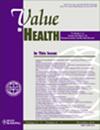Healthcare Costs in the United States by Demographic Characteristics and Comorbidity Status
IF 4.9
2区 医学
Q1 ECONOMICS
引用次数: 0
Abstract
Objectives
Current, real-world healthcare cost information is needed to project future expenditures and inform policy. We estimated the healthcare costs for adults in 2019 in the United States by age, sex, race/ethnicity, geographic region, and comorbidity.
Methods
We aggregated and summarized the healthcare costs in 2021 US dollars using claims data derived from Optum’s deidentified Clinformatics® Data Mart Database, which includes inpatient, outpatient, and prescription claims for commercial and Medicare Advantage beneficiaries nationwide.
Results
A total of 9 227 901 adults were included in the analysis. The largest group represented was 71 to 75 years old (13%), female (53%), White (68%), received care in the South (41%), and had commercial health insurance (56%). There was a positive relationship between healthcare cost and age. Females had a 1.3-fold multiplicative increase in costs than males (95% CI 1.33–1.34). There were 92.5% of individuals who had health claims in the Northeast, 89.6% in the Midwest, 88.9% in the South, 77.1% in the West, and 12.7% with unknown geographic region. Patients with severe renal failure, heart failure, or metastatic cancer incurred the highest mean yearly costs ($139 844, $113 031, and $85 299, respectively). Metastatic cancer and severe renal failure were associated with a 5.3-fold multiplicative increase in costs than not having these conditions, after adjusting for potential confounders (95% CI 5.26–5.41 and 4.98–5.16, respectively).
Conclusions
We identified patient characteristics and medical conditions that are associated with high healthcare cost burden and could benefit from tailored interventions. We provided detailed cost estimates to aid healthcare modeling, cost projection, and cost-minimizing interventions.
按人口特征和合并症状况分列的美国医疗费用。
目的:需要当前真实世界的医疗成本信息来预测未来支出并为政策提供信息。我们按年龄、性别、种族/人种、地理区域和合并症估算了美国成年人 2019 年的医疗成本:我们使用 Optum 的去标识 Clinformatics® Data Mart 数据库中的理赔数据,以 2021 年美元为单位对医疗费用进行了汇总:共有 9,227,901 名成年人参与了分析。其中最大的群体为 71-75 岁(13%)、女性(53%)、白人(68%)、在南方接受医疗服务(41%)、拥有商业医疗保险(56%)。医疗费用与年龄呈正相关。与男性相比,女性的费用增加了 1.3 倍(95% CI 1.33-1.34)。92.5% 的人在东北部、89.6% 的人在中西部、88.9% 的人在南部、77.1% 的人在西部,还有 12.7% 的人地域不详。严重肾功能衰竭、心力衰竭或转移性癌症患者的年平均费用最高(分别为 139844 美元、113031 美元和 85299 美元)。在对潜在的混杂因素进行调整后,转移性癌症和严重肾功能衰竭与没有这些病症的患者相比,费用增加了 5.3 倍(95% CI 分别为 5.26-5.41 和 4.98-5.16):我们发现了与高医疗成本负担相关的患者特征和医疗条件,这些特征和条件可从有针对性的干预措施中获益。我们提供了详细的成本估算,以帮助进行医疗建模、成本预测和成本最小化干预。
本文章由计算机程序翻译,如有差异,请以英文原文为准。
求助全文
约1分钟内获得全文
求助全文
来源期刊

Value in Health
医学-卫生保健
CiteScore
6.90
自引率
6.70%
发文量
3064
审稿时长
3-8 weeks
期刊介绍:
Value in Health contains original research articles for pharmacoeconomics, health economics, and outcomes research (clinical, economic, and patient-reported outcomes/preference-based research), as well as conceptual and health policy articles that provide valuable information for health care decision-makers as well as the research community. As the official journal of ISPOR, Value in Health provides a forum for researchers, as well as health care decision-makers to translate outcomes research into health care decisions.
 求助内容:
求助内容: 应助结果提醒方式:
应助结果提醒方式:


